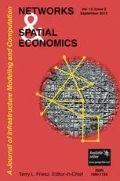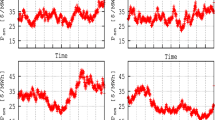Abstract
In northern Europe, wind energy has become a dominate renewable energy source, due to natural conditions and national support schemes. However, the uncertainty about wind generation affects existing network infrastructure and power production planning of generators, which cannot be fully diminished by wind forecasts. In this paper we develop a stochastic electricity market model to analyze the impact of uncertain wind generation on the different electricity markets as well as network congestion management. Stochastic programming techniques are used to incorporate uncertain wind generation. The technical characteristics of transporting electrical energy as well as power plants are explicitly taken into account. The consecutive clearing of the electricity markets is incorporated by a rolling planning procedure reflecting the market regime of European markets. The model is applied to the German electricity system covering one week. Two different approaches of considering uncertain wind generation are analyzed and compared to a deterministic approach. The results reveal that the flexibility of generation dispatch is increased either by using more flexible generation technologies or by operating rather inflexible technologies under part-load conditions.










Similar content being viewed by others
Notes
Stochastic models allow for an explicit representation of the sources of uncertainty reflected through multiple scenarios with associated probabilities, whereas in deterministic optimization models all input parameters are assumed to be certain or deterministic. Fundamentals of stochastic optimization can be found in Birge and Louveaux (1997) and Kall and Wallace (1994). With respect to energy, Wallace and Fleten (2003) provide a survey of different stochastic programming models and their application to the energy sector. Herein, stochastic versions of the unit commitment, generation dispatch, as well as optimal power flow are presented and solution methods are discussed. Additionally, an overview of different applications of stochastic programming with a focus on electricity systems is given in Weber (2005), Kallrath et al. (2009), Möst and Keles (2010), and Conejo et al. (2010).
Devine et al. (2014) applies a similar concept to replicate the clearing of the UK natural gas markets considering stochastic demand.
Moreover, the economic relevance of transmission networks in electricity systems is not limited to the short-term congestion perspective. Jonkeren et al. (2014) investigate the impact of critical infrastructure failures and develop a modeling framework to quantify the economic implications. Furthermore, Abrell and Weigt (2012) analyze the interaction effects between different energy infrastructures. They show that the interaction of congestion in electricity transmission and natural gas pipeline networks can lead to unexpected consequences of energy regulation.
A list of the notation used is given in the appendix.
It is important to note that a deterministic dayahead market setup may underestimate the effects of an equivalent stochastic setup. However, a unique dayahead renewable forecast is assumed for two reasons: from a market perspective, marketers of renewable energy have to place a bid in the dayahead market specifying the deliverable amount of electricity. Therefore, the amount of renewable energy may be based on an evaluation of underlying uncertainties, but the offered amount itself is then deterministic. Moreover, from a methodological perspective, the incorporation of uncertain renewable generation in a stochastic modeling setup requires the specification of technology-specific recourse costs for adjusting the first stage decision. These costs may be higher than the direct marginal generation costs due to additional transaction costs as corrective bidding may be required in the intraday market.
In general, we continue the notation given above. However, due to the stochastic programming approach, the variables are additionally indexed by the set of nodes in the scenario tree k⊂K.
http://www.transparency.eex.com/en, accessed January 24, 2014
http://www.gams.de/dd/docs/solvers/scenred2.pdf, accessed June 6, 2013
Moreover, incorporating a price-sensitive load through a load curve requires, firstly, the specification of the load curve type (e.g. affine or exponential) and sensitive parameters (e.g. elasticity). Secondly, it increases complexity and reduces solvability of the unit commitment models due to the introduction of non-linear elements. See e.g. De Jonghe et al. (2014) for an application of price responsive load.
NUTS (Nomenclature of Territorial Units for Statistics) is a hierarchical system for geographic division of the European territory.
The expected value of the approximated distribution is always equal to the expected value used in the Changing Forecast case.
Conventional generation technologies are grouped into baseload (nuclear, lignite), midload (hard coal), flexible midload (CCGT), and peakload (OCGT, gas steam, CCOT, OCOT, oil steam, and pumped-hydro storage).
References
50Hertz Transmission, Amprion, TransnetBW, TenneT TSO (2012). EEG Anlagenstammdaten. http://www.netztransparenz.de/de/Anlagenstammdaten.htm
Abrell J, Weigt H (2012) Combining energy networks. Netw Spat Econ 12(3):377–401
Bagemihl J (2003) Optimierung eines Portfolios mit hydro-thermischem Kraftwerkspark im börslichen Strom- und Gasterminmarkt. PhD thesis, Institute of Energy Economics and the Rational Use of Energy, University of Stuttgart, URL http://elib.uni-stuttgart.de/opus/volltexte/2003/1387/pdf/bagediss_gesamt.pdf
Baldick R (1995) The generalized unit commitment problem. IEEE Trans Power Syst 10(1):465–475. doi:10.1109/59.373972
Barth R, Söder L, Weber C, Brand H, Swider DJ (2006) Wilmar Deliverable 6.2 (d)– Methodology of the Scenario Tree Tool, Documentation. Tech. rep., Institute of Energy Economics and the Rational Use of Energy, University of Stuttgart. http://www.wilmar.risoe.dk/
Birge JR, Louveaux F (1997) Introduction to Stochastic Programming. Springer-Verlag Inc, New York
BNetzA (2012) List of Power Plants. http://www.bundesnetzagentur.de/cln_1932/EN/Areas/ElectricityGasRegulation/SpecialTopics/PowerPlantList/PubliPowerPlantList_node.html;jsessionid=79D374DC200620EB705734DCE17E6361, Bundesnetzagentur (BNetzA)
Borggrefe F, Neuhoff K (2011) Balancing and intraday market design: Options for wind integration. DIW Discussion Paper 1162, URL http://www.diw.de/sixcms/detail.php?id=diw_01.c.387259.de
Bouffard F, Galiana FD (2008) Stochastic security for operations planning with significant wind power generation. IEEE Trans Power Syst 23(2):306–316. doi:10.1109/TPWRS.2008.919318
Conejo A, Carrión M, Morales J (2010) Decision making under uncertainty in electricity markets, vol 153. Springer Verlag
De Jonghe C, Hobbs BF, Belmans R (2014) Value of price responsive load for wind integration in unit commitment. IEEE Trans Power Syst 29(2):675–685
Devine MT, Gleeson JP, Kinsella J, Ramsey DM (2014) A rolling optimisation model of the uk natural gas market. Netw Spat Econ 14(2):209–244
DEWI, EON Netz, EWI, RWE Transportnetz Strom, VE Transmission (2005) Energiewirtschaftliche Planung fur die Netzintegration von Windenergie in Deutschland an Land und Offshore bis zum Jahr 2020. Tech. rep., German Energy Agency (dena), Berlin, Germany, URL http://www.dena.de/fileadmin/user_upload/Download/Dokumente/Projekte/ESD/netzstudie1/dena-Netzstudie_l.pdf
Dupac̆ová J, Gröwe-Kuska N, Römisch W (2003). Math Program 95:493–511. doi:10.1007/s10107-002-0331-0
ENTSO-E (2012) Entso-e grid map. https://www.entsoe.eu/resources/grid-map/, European Network of Transmission System Operators for Electricity (ENTSO-E)
ENTSO-E (2014) Consumption data. https://www.entsoe.eu/resources/data-portal/consumption/, European Network of Transmission System Operators for Electricity (ENTSO-E)
Eurostat (2011) Regional statistics. http://epp.eurostat.ec.europa.eu/portal/page/portal/region_cities/regional_statistics/data/database, Statistical Office of the European Union
EWEA (2011) Wind in power - 2010 European statistics. Tech. rep., European Wind Energy Association (EWEA), http://www.ewea.org/fileadmin/ewea_documents/documents/statistics/EWEA_Annual_Statistics_2010.pdf
Habis H, Csercsik D (2014) Cooperation with externalities and uncertainty. Netw Spat Econ
Heitsch H, Römisch W (2003) Scenario reduction algorithms in stochastic programming. Comput Optim Appl 24:187–206. doi:10.1023/A:1021805924152
Hundt M, Barth R, Sun N, Wissel S, Voß A (2009) Verträglichkeit von erneuerbaren Energien und Kernenergie im Erzeugungsportfolio– Technische und ökonmische Aspekte. Tech. rep., E.On Energie AG, Munich, Germany
IPCC (2006) 2006 IPCC Guidelines for National Greenhouse Gas Inventories, Volume 2 Energy. http://www.ipcc-nggip.iges.or.jp/public/2006gl/pdf/2_Volume2/V2_2_Ch2_Stationary_Combustion.pdf, Intergovernmental Panel on Climate Change
Jonkeren O, Azzini I, Galbusera L, Ntalampiras S, Giannopoulos G (2014) Analysis of critical infrastructure network failure in the european union: A combined systems engineering and economic model. Networks and Spatial Economics
Kall P, Wallace SW (1994) Stochastic programming. John Wiley & Sons, Chichester
Kallrath J, Pardalos PM, Rebennack S, Scheidt M (eds) (2009) Optimization in the energy industry. Springer-Verlag, Berlin
Kießling F, Nefzger P, Kaintzyk U (2001) Freileitungen - Planung, Berechnung, Ausfuhrung̈. Springer, Berlin
Kunz F (2013) Improving congestion management - how to facilitate the integration of renewable generation in Germany. Energ J 34(4):55–78
Leuthold F, Weigt H, von Hirschhausen C (2009) When the Wind Blows Over Europe - A Simulation Analysis and the Impact of Grid Extensions. Dresden University of Technology, Chair of Energy Economics, Electricity Market Working Paper WP-EM-31. http://www.ee2.biz
Leuthold F, Weigt H, von Hirschhausen C (2012) A large-scale spatial optimization model of the European electricity market. Netw Spat Econ 12(1):75–107
Metzler C, Hobbs BF, Pang JS (2003) Nash-cournot equilibria in power markets on a linearized dc network with arbitrage: Formulations and properties. Netw Spat Econ 3(2):123–150
Möst D, Keles D (2010) A survey of stochastic modelling approaches for liberalised electricity markets. Eur J Oper Res 207(2):543–556. doi:10.1016/j.ejor.2009.11.007
Neuhoff K, Barquin J, Bialek J, Boyd R, Dent C, Echavarren F, Grau T, von Hirschhausen C, Hobbs BF, Kunz F, Nabe C, Papaefthymiou G, Weber C, Weigt H (2013) Renewable electric energy integration: quantifying the value of design of markets for international transmission capacity. Energ Econ 40:760–772
Oggioni G, Smeers Y, Allevi E, Schaible S (2012) A generalized nash equilibrium model of market coupling in the european power system. Netw Spat Econ 12:503–560. doi:10.1007/s11067-011-9166-7
Padhy NP (2004) Unit commitment-a bibliographical survey. IEEE Trans Power Syst 19(2):1196–1205. doi:10.1109/TPWRS.2003.821611
Papavasiliou A, Oren SS (2013) Multiarea stochastic unit commitment for high wind penetration in a transmission constrained network. Oper Res 61(3):578–592. doi:10.1287/opre.2013.1174. http://pubsonline.informs.org/doi/abs/10.1287/opre.2013.1174
Pritchard G, Zakeri G, Philpott A (2010) A single-settlement, energy-only electric power market for unpredictable and intermittent participants. Oper Res 58(4-part-2):1210–1219. doi:10.1287/opre.1090.0800
Ruiz PA, Philbrick CR, Zak E, Cheung KW, Sauer PW (2009) Uncertainty management in the unit commitment problem, vol 24, pp 642–651. doi:10.1109/TPWRS.2008.2012180
Schröter J (2004) Auswirkungen des europischen Emissionshandelssystems auf den Kraftwerkseinsatz in Deutschland. Master’s thesis, Technische Universität Berlin, Institut für Energietechnik, Fachgebiet Energiesysteme, http://www.ensys.tu-berlin.de/uploads/media/schroeter_2004_auswirkungen_co2_zertifikatehandel.pdf
Spiecker S, Weber C (2014) The future of the european electricity system and the impact of fluctuating renewable energy a scenario analysis. Energ Policy 65:185–197
Statistik der Kohlenwirtschaft (2013) Entwicklung ausgewählter Energiepreise. http://www.kohlenstatistik.de/files/enpr.xlsx
Traber T, Kemfert C (2011) Gone with the wind? - electricity market prices and incentives to invest in thermal power plants under increasing wind energy supply. Energy Econ 33:240–259
Tuohy A, Meibom P, Denny E, O’Malley M (2009) Unit commitment for systems with significant wind penetration. IEEE Trans Power Syst 24(2):592–601. doi:10.1109/TPWRS.2009.2016470
Wallace SW, Fleten SE (2003) Stochastic Programming Models in Energy, Handbooks in Operations Research and Management Science, vol 10, chap 10. Elsevier, Amsterdam, pp 637–677
Wang J, Shahidehpour M, Li Z (2008) Security-constrained unit commitment with volatile wind power generation. IEEE Trans Power Syst 23(3):1319–1327. doi:10.1109/TPWRS.2008.926719
Wang J, Botterud A, Bessa R, Keko H, Carvalho L, Issicaba D, Sumaili J, Miranda V (2011) Wind power forecasting uncertainty and unit commitment. Appl Energy 88(11):4014–4023. http://dx.doi.org/10.1016/j.apenergy.2011.04.011
Weber C (2005) Optimization in the electric power industry: methods and models for decision support. Springer, Boston
Weber C, Meibom P, Barth R, Brand H, Pardalos PM, Kallrath J, Pardalos PM, Rebennack S, Scheidt M (2009) Wilmar: A stochastic programming tool to analyze the large-scale integration of wind energy. Springer, Berlin, pp 437–458
Weigt H, Jeske T, Leuthold F, von Hirschhausen C (2010) Take the long way down: Integration of large-scale North Sea wind using HVDC transmission. Energy Policy 38(7):3164–3173
van der Weijde AH, Hobbs BF (2012) The economics of planning electricity transmission to accommodate renewables: Using two-stage optimisation to evaluate flexibility and the cost of disregarding uncertainty. Energy Econ 34:2089–2101
Acknowledgments
Friedrich Kunz acknowledges financial support of the Mercator foundation and the RWE fellowship program (RWE Studienförderung). The authors thank Christian von Hirschhausen and Hannes Weigt for comments.
Author information
Authors and Affiliations
Corresponding author
Rights and permissions
About this article
Cite this article
Abrell, J., Kunz, F. Integrating Intermittent Renewable Wind Generation - A Stochastic Multi-Market Electricity Model for the European Electricity Market. Netw Spat Econ 15, 117–147 (2015). https://doi.org/10.1007/s11067-014-9272-4
Published:
Issue Date:
DOI: https://doi.org/10.1007/s11067-014-9272-4




